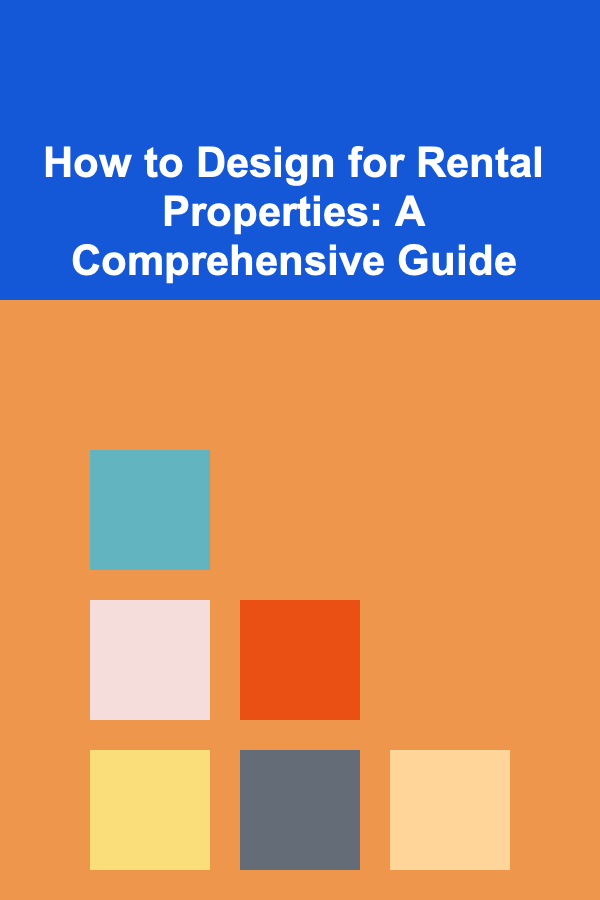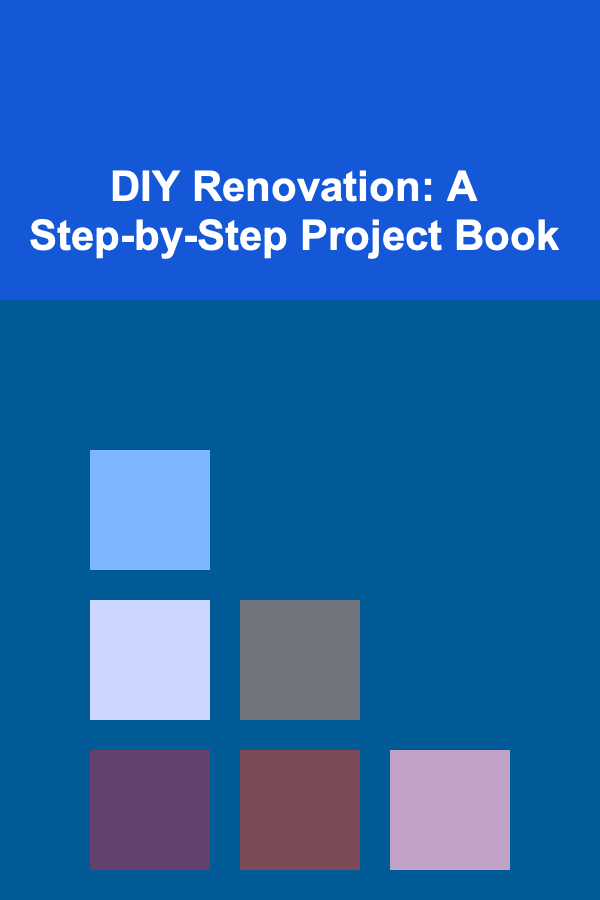
How to Design for Rental Properties: A Comprehensive Guide
ebook include PDF & Audio bundle (Micro Guide)
$12.99$6.99
Limited Time Offer! Order within the next:

Designing rental properties presents a unique set of challenges. Landlords and property managers need to consider various factors, such as the preferences of potential tenants, long-term durability, cost-effectiveness, and how to create a space that appeals to a wide audience while maximizing rental income. In this article, we'll delve into how to design rental properties effectively, focusing on the aesthetics, functionality, and practical considerations that ensure a property stands out in a competitive rental market.
Understanding the Rental Market
Before diving into design tips, it's important to understand the rental market and tenant demographics. Rental properties can range from short-term vacation rentals to long-term leases, each with its own set of design considerations.
- Target Audience: Know who your potential tenants are. Young professionals, families, and students all have different expectations for their living spaces. Researching the demographic of your target audience is the first step to tailoring your design.
- Location Matters: The location of the property influences its design. Urban apartments typically demand a sleek, modern design, while properties in suburban or rural areas might call for a more relaxed and homely atmosphere.
- Budget and Return on Investment (ROI): Your design choices should align with your budget. It's crucial to balance aesthetic appeal with cost-effectiveness, ensuring that any upgrades will generate a reasonable return on investment.
- Longevity and Durability: Rental properties often face more wear and tear than owner-occupied homes, so durability should be at the forefront of your design choices. This means selecting materials, finishes, and furnishings that are tough, easy to maintain, and resistant to damage.
With these considerations in mind, let's explore the essential aspects of designing rental properties.
Prioritize Functionality
When designing for rental properties, functionality should always come first. Tenants want a space that works for their lifestyle while being comfortable and practical. Here's how to prioritize functionality:
Open and Flexible Floor Plans
A spacious, open floor plan appeals to a wider range of tenants. Many modern renters prefer open-concept spaces that blend living, dining, and kitchen areas. Open layouts create a sense of space, making even smaller properties feel larger. Flexibility is key, so avoid heavy partitioning that could limit tenant customization.
Smart Storage Solutions
Storage space is often one of the biggest complaints in rental properties. Without built-in storage, tenants may struggle with organizing their belongings. To remedy this, incorporate custom shelving, built-in cabinets, and multi-purpose furniture like beds with drawers or desks that double as vanity units. Adding closet organizers such as shelves, racks, and hooks also maximizes available space.
Functional Kitchens and Bathrooms
Kitchens and bathrooms are two areas where tenants expect both practicality and style. In the kitchen, focus on durable, easy-to-clean materials like quartz or laminate countertops, stainless steel appliances, and modern but low-maintenance cabinetry. For the bathroom, consider installing low-flow showerheads and toilets to appeal to environmentally conscious renters while also reducing water costs.
Choose Timeless and Neutral Design Styles
To appeal to a broad audience, it's best to choose neutral tones and timeless designs. While personal style may vary, a neutral base allows tenants to add their own personal touches without clashing with the existing decor.
Neutral Color Palettes
Opt for neutral colors like whites, grays, and beiges for walls, trim, and larger pieces of furniture. These tones are universally appealing and create a serene, welcoming environment. Neutral palettes also make it easier for tenants to move in and decorate with their own items, as they won't have to worry about clashing colors.
Durable Flooring
The type of flooring you choose can make or break a rental property design. Hardwood floors are a classic option, but they can be expensive and prone to scratching. Consider alternatives like engineered wood, laminate, or vinyl plank flooring, which mimic the look of hardwood but are more durable and cost-effective. These options are especially ideal for high-traffic areas like living rooms and kitchens.
For bathrooms and kitchens, tile is often the best option. Choose large-format tiles in neutral tones for a modern, sleek look. Ceramic or porcelain tiles are easy to clean and can handle the wear and tear of daily use.
Simple and Elegant Furnishings
When furnishing a rental property, simplicity and elegance are the key. Avoid overly personal or trendy items that may not appeal to all renters. Instead, invest in durable and functional pieces, such as a comfortable couch, a sturdy dining table, and practical bed frames. Opt for furniture that can easily transition between different design preferences and that can endure the test of time.
Incorporate Low-Maintenance Features
Maintenance can be a significant burden for landlords, so it's essential to design with low-maintenance features in mind. By reducing upkeep, you save time and money while ensuring the property stays in top condition for tenants.
Easy-to-Clean Surfaces
Select materials that are easy to maintain and clean. For example, use wipeable paints on walls and cabinets, especially in high-traffic areas. Quartz countertops are durable and easy to wipe down compared to granite or marble, which require more care.
In bathrooms, opt for grout-free shower panels or fiberglass tubs, which are much easier to maintain than traditional tiles. These features not only look modern but also help reduce the amount of time tenants need to spend cleaning.
Energy-Efficient Appliances
Energy-efficient appliances are an attractive feature for tenants who want to keep their utility bills low. Install high-efficiency dishwashers, refrigerators, and washing machines. Additionally, LED lighting and programmable thermostats can help manage energy usage, making the property more sustainable and appealing to eco-conscious renters.
Consider the Comfort of Tenants
A rental property needs to be more than just functional and stylish; it should also offer a comfortable and inviting atmosphere. Here's how you can enhance comfort:
Proper Lighting
Lighting plays a crucial role in the comfort of a space. Ensure that every room is well-lit with a mix of ambient, task, and accent lighting. Overhead lights should provide sufficient illumination, but also add lamps and lighting fixtures to create a warm and cozy atmosphere.
Dimmer switches are a simple and effective way to offer flexibility in lighting. They give tenants the option to adjust the lighting to suit their needs, whether they're working, relaxing, or entertaining guests.
Temperature Control
Thermal comfort is critical in any rental property. Make sure the property has an effective heating and cooling system, such as a central air conditioning unit or individual room heaters. Ceiling fans can also help regulate air circulation and keep the space comfortable year-round.
Additionally, consider adding insulation to walls, windows, and doors to help maintain a comfortable temperature and reduce energy consumption. Draft-proofing is an easy and inexpensive way to make a property more energy-efficient.
Noise Control
Noise is a common concern for renters, particularly in multi-unit buildings. Consider using soundproof materials in walls, floors, and ceilings to reduce noise transmission. Installing thick carpeting or rugs can help absorb sound in high-traffic areas, while double-glazed windows can minimize external noise.
Highlight Outdoor Spaces
Outdoor spaces are a major selling point for rental properties. Whether it's a balcony, garden, or patio, a well-designed outdoor space can provide additional value and attract tenants looking for a connection to nature.
Functional Outdoor Areas
Design outdoor spaces with functionality in mind. A small balcony can be turned into a cozy reading nook, while a larger backyard can be set up for outdoor dining or lounging. Adding simple outdoor furniture, like a table and chairs or a bench, can make a significant impact without being too costly.
Consider planting low-maintenance landscaping features, such as drought-tolerant plants or shrubs, to enhance the outdoor appeal. Tenants are often looking for outdoor areas where they can relax, entertain, or even grow their own herbs or vegetables.
Personalization and Customization
While rental properties are typically neutral, it's important to allow tenants the flexibility to personalize their living space. Offer opportunities for renters to make the space feel like their own while still maintaining a cohesive and well-designed environment.
Temporary Design Solutions
Consider offering temporary design solutions such as peel-and-stick wallpaper or removable decals for tenants who want to personalize the space without making permanent changes. Temporary shelves or hooks can also give tenants flexibility in their storage options.
Allowing small changes, such as painting accent walls or hanging pictures, can help tenants feel more at home. However, be sure to set clear guidelines on what alterations are permissible to avoid any damage to the property.
Conclusion
Designing rental properties is about finding the balance between creating a stylish, comfortable, and functional space while ensuring durability and cost-effectiveness. By focusing on timeless design, durability, and tenant comfort, you can create a property that attracts high-quality tenants and ensures long-term success in the competitive rental market.
With the right choices, a well-designed rental property will not only increase tenant satisfaction but also maximize your return on investment, making it a worthwhile venture for landlords and property managers alike.

Business Consultant's Handbook: Unlocking Potential and Maximizing Profit
Read More
How to Create Inviting Party Favors on a Budget
Read More
How To Give Back to the Community as an Entrepreneur
Read More
How To Improve Intimacy and Passion
Read More
DIY Renovation: A Step-by-Step Project Book
Read More
How to Use Observational Comedy to Write Material
Read MoreOther Products

Business Consultant's Handbook: Unlocking Potential and Maximizing Profit
Read More
How to Create Inviting Party Favors on a Budget
Read More
How To Give Back to the Community as an Entrepreneur
Read More
How To Improve Intimacy and Passion
Read More
DIY Renovation: A Step-by-Step Project Book
Read More